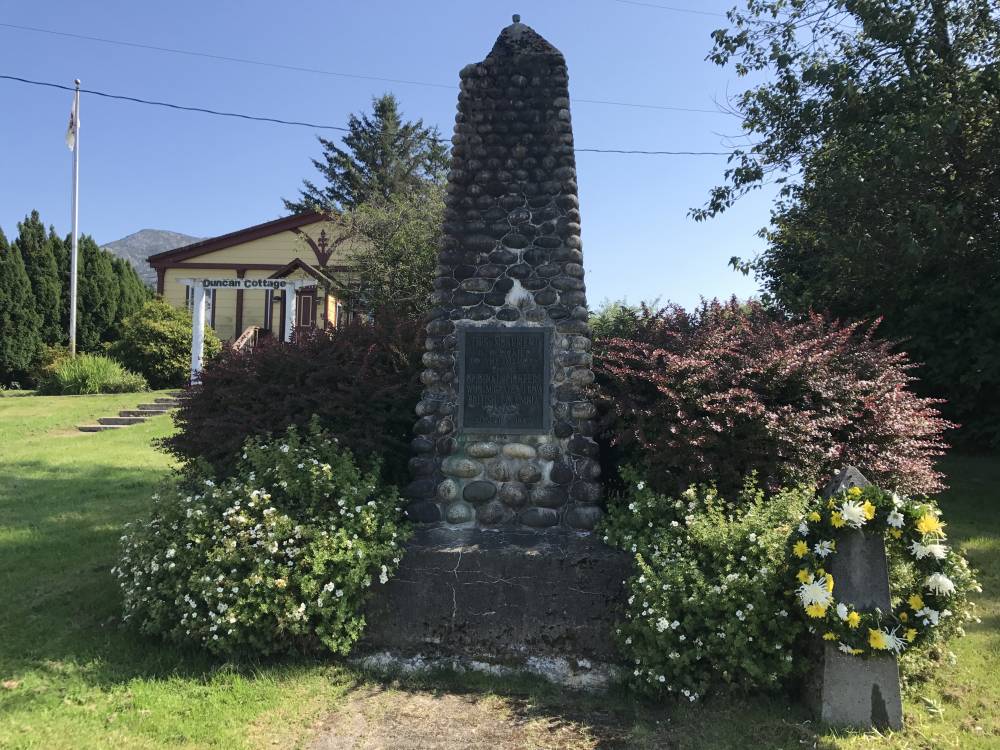
Last week, Metlakatlans celebrated their 132nd Founders’ Day. An afternoon full of events such as three-legged races and tug-a-war can often overshadow the true meaning of the day.
On August 7, the day-long festivities began with wreath laying ceremonies outside the Duncan Cottage Museum and the William Duncan Memorial Church. Before laying the wreaths, David R. Boxley presented a speech about the history of the community.
“[sm’algyax language] It’s very important that we remember our ancestors today. And that we never forget why this community exists,” said Boxley.
The second wreath laying ceremony ended with the crowd singing “Amazing Grace” in the Tsimshian language, sm’algyax.
Created by Kandi McGilton, David R. Boxley, and Gavin Hudson in 2015, the Haayk Foundation aims to preserve sm’algyax by producing language materials. Boxley says the foundation and community members wanted to come together on Founders’ Day to make sure the community remembers the true meaning of the day.
“It’s just so that we take a few solemn moments out of the day because there’s all those games down at the ball field and people will be setting off fireworks later—it’s very much like a second Fourth of July,” said Boxley. “We feel it’s very important to take a few minutes and remember why we’re here—who’s responsible for this community being here for us.”
In 1857, missionary William Duncan went to Fort Simpson, British Colombia and later established Metlakatla B.C. with his religious followers in 1862. But, the Canadian government passed an amendment to the Indian Act in 1884, which further limited the rights of Canada’s indigenous tribes.
“When that law in Canada [was passed], we weren’t human beings—three-quarters human,” said Boxley. “Man, I can’t even imagine what that must have been like to try to—you’re living your life the same way you have for 10,000 years, and all of sudden these people show up and say, ‘None of that’s yours anymore, you can’t be like that.’”
Instead of fighting and risking their lives, some of the Tsimshians decided to leave. They sent scouting parties to Alaska, and Duncan went to Washington D.C. for permission to settle in the US territory. Chief Johnson in Ketchikan recommended a Tlingit village that had been abandoned for about 50 years. On August 7, 1887, William Duncan and other dignitaries went to Annette Island and it became the new Metlakatla.
But, Duncan discouraged traditions such as the practice of potlatches and consulting shamans when sick. The new Metlakatla residents also gave up traditional positions as chiefs and formed a 12-member council instead.
“They tried their best in a world that didn’t belong to them anymore, to make a future for their people in the only way that was available to them,” said Boxley. “It was a time where Native people had no control over their future. But somehow, we did.”
Tsimshian culture has seen a resurgence in recent years. Despite the traditions Duncan asked them to sacrifice, Boxley takes pride as a descendent of the only Tsimshian community in Southeast Alaska during that time.
“And he was a big part of that,” said Boxley. “We’re a Christian community and he was our leader, but our people did it. We made the decision to move. We built the buildings—it was ours.”
As the day continued, a festive parade of various groups walked through the streets of Metlakatla, waving to crowds and throwing candy. Dance leader Jennifer McCarty with the 4th Generation Dance Group teaches songs and dances so her children can learn and continue to pass them down. She says celebrating Founders’ Day is a fun way to share their heritage.
“Founders’ Day is just a really fun way to remember where we came from,” said McCarty. “A lot of communities don’t know the history behind their town or village, and I think ours is pretty unique in that we can remember and recall 132 years ago.”





